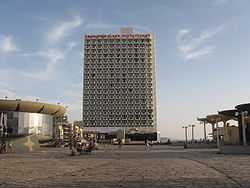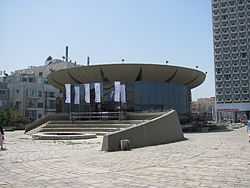Atarim Square
Coordinates: 32°05′8″N 34°46′10″E / 32.08556°N 34.76944°E


Atarim Square (Also known as Namir Square) is a complex of buildings and a public square designed by architect Yaakov Rechter. It reflects the style and of one of the highlights of brutalism in Israel. Loaf unusual sites near the beach in Tel Aviv over Eliezer Peri Street, and connected to the boardwalk and marina west of Tel Aviv, Sderot Ben-Gurion (Ben-Gurion Boulevard) and Hayarkon Street. West of the square is Gordon Pool.
Sites Square multi-purpose structure was built a number of levels, which exploited the difference in elevations between the cliff where the beach was. The lower level includes a parking lot and gas station. The level above which includes a covered highway (Eliezer Peri Street). Over two levels of indoor shops and upper level (roof structure) is broad, including a number of restaurants, an amphitheater and a circular structure coated glass (known C"mbna Coliseum "). Northern part of the square is another building which includes the Marina Hotel and several floors of shops.
History
Before construction of the square building housed The neighborhood consisted of shacks and shanties. The neighborhood was established temporary residence to Jewish refugees forced to flee from Jaffa during the Jaffa riots of 1921 and for new immigrants. The beach neighborhood was subject to frequent winter flooding and high winds.
In the fifties began to evacuate the neighborhood. In the sixties the Tel Aviv municipality decided to develop the city's northern beaches, and to build modern hotels along the coast. Development project, it was decided to build The neighborhood location of the tourist center that will connect the hotels, beaches and Sderot Ben-Gurion, and will also include a main road parallel to the shore and parking lot. To build these Hfreuitim established urban society "sites", which later was named the plaza. Central planning tourism planned by architect Yaakov Rechter.
Construction begins
Square sites began to be built in 1971, and was inaugurated in June 1975. In the early years the square was full of life: the curved concrete structure level extension department operated a branch of peace. Also two levels of shops and restaurants in the square were a success. The northern structure established duty-free stores for tourists. Follow one of the lower levels seagull theater. The building included a total of two hundred businesses.
Decline of the Square
In the late seventies, the trend was reversed: criminal elements took over the shops, and where even the police station was established, the lower levels of shops were closed or gambling clubs. A branch of peace is closed, and the curve was abandoned several years. Residents and tourists stayed foot away, and instead showed signs of neglect. In 1982 won the upper level except for tenderness, when it opened in the rotunda "Colosseum Club", which operated until the late nineties. However the success of the Colosseum, which was the largest club in the country (and argued that the Middle East), failed to cause recovery of the square. Nineties movie also closed Shahaf. During the first Gulf War in 1991, even said Mayor Shlomo Lahat, that he would prefer to make the destruction of Scud missile square.
Square's name was changed in the seventies sites Namir Square, named after Mordechai Namir, mayor of Tel Aviv-Jaffa. After the failure of the square, Namir's widow, Ora Namir, requested that her late husband's name be withdrawn from the square and for him to be honored some other way. The former Haifa Road is now named for Namir.
Attempt at renovation
The municipality is trying to promote programs for years or even destruction of the square only to be renovated, but a tangle of legal problems preventing it. The essence of the problem is that the structure of the plaza is private ownership of dozens of property owners in the square (including part of the public areas), who are unable to cooperate in maintaining the square. Unlike malls, there is no square holding company and in fact there is no factor to manage and maintain it. Even the building materials, low quality of the square was built, as well as proximity to the sea, contributing to rapid wear of the square.
Current status
Today the square is almost deserted, crumbling, neglected, abandoned when most shops. However, recently began renovating the curve used by the Coliseum and watching the glass, and painted several buildings on the expansion as well as safety deficiencies were corrected in the square.
Nowadays, the site is considered one of the most unsuccessful projects built in Tel Aviv, together with the new Central Station project led to serious consequences as well. She is a symbol of its failure of the massive building concept of the next beach at the expense of saving the natural beach, and severing the city from the sea (now, after the enactment of the Law for the Protection of the Coastal Environment not have been possible construction of such project near the beach). This criticism was made even as the square was planned, especially the separation of Sderot Ben - Gurion sea. Richter's original design that actually connect the cord with the square so that the sea would see her, but due to constraints arising from the fact that the road underpass could not be below sea level, the square was elevated slightly but to such a degree sea view is blocked.
References
External links
| Wikimedia Commons has media related to Kikar Atarim. |
| ||||||